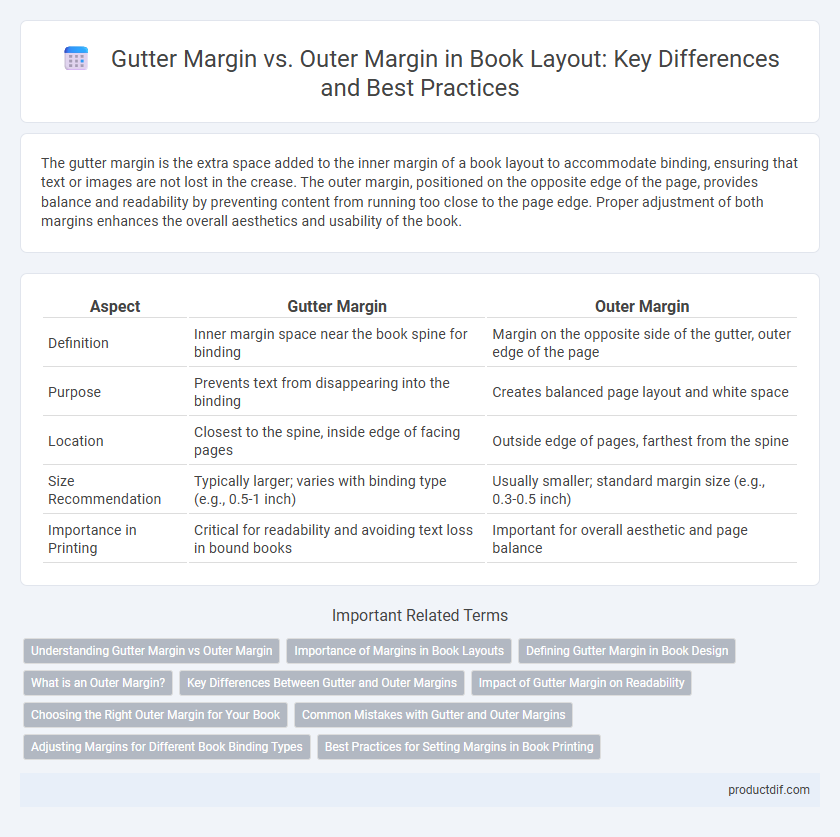The gutter margin is the extra space added to the inner margin of a book layout to accommodate binding, ensuring that text or images are not lost in the crease. The outer margin, positioned on the opposite edge of the page, provides balance and readability by preventing content from running too close to the page edge. Proper adjustment of both margins enhances the overall aesthetics and usability of the book.
Table of Comparison
| Aspect | Gutter Margin | Outer Margin |
|---|---|---|
| Definition | Inner margin space near the book spine for binding | Margin on the opposite side of the gutter, outer edge of the page |
| Purpose | Prevents text from disappearing into the binding | Creates balanced page layout and white space |
| Location | Closest to the spine, inside edge of facing pages | Outside edge of pages, farthest from the spine |
| Size Recommendation | Typically larger; varies with binding type (e.g., 0.5-1 inch) | Usually smaller; standard margin size (e.g., 0.3-0.5 inch) |
| Importance in Printing | Critical for readability and avoiding text loss in bound books | Important for overall aesthetic and page balance |
Understanding Gutter Margin vs Outer Margin
Gutter margin refers to the extra space added to the inner margin of a book's layout to accommodate binding, preventing text from being obscured near the spine. Outer margin is the space along the outer edge of the page, providing balance and improving readability by separating the text block from the page edge. Understanding the difference between gutter margin and outer margin is crucial for designers to ensure proper text alignment and user-friendly book formatting.
Importance of Margins in Book Layouts
Gutter margin and outer margin play crucial roles in book layouts by ensuring readability and proper binding. The gutter margin, positioned near the spine, prevents text from being lost or obscured during the binding process. Outer margins provide space for visual balance and reader comfort, enhancing the overall aesthetics and functionality of the page design.
Defining Gutter Margin in Book Design
Gutter margin refers to the inner margin space adjacent to the book's spine, designed to prevent text from being obscured during binding. It ensures readability by providing extra space where pages are bound, differing from the outer margin, which borders the page edges away from the spine. Proper gutter margin adjustment is crucial for maintaining consistent text alignment and avoiding loss in the book's fixed layout.
What is an Outer Margin?
An outer margin is the blank space along the outer edge of a book page, opposite the gutter margin near the spine. It provides visual balance, prevents text from running too close to the edge, and enhances readability. Properly sized outer margins contribute to the book's aesthetics and user comfort during reading.
Key Differences Between Gutter and Outer Margins
Gutter margins are specifically designed to provide extra space for binding in printed books, preventing text from being obscured near the spine. Outer margins, by contrast, are the blank spaces along the edges of a page opposite the gutter, primarily used to enhance readability and aesthetics. The key difference lies in function: gutter margins accommodate binding needs, while outer margins ensure visual balance and ease of reading.
Impact of Gutter Margin on Readability
The gutter margin, positioned near the book's spine, is essential for preventing text from disappearing into the binding, significantly enhancing readability in printed books. Unlike the outer margin, which provides space around the page edges for aesthetic balance and handling, the gutter margin ensures content remains fully visible and accessible, especially in thick volumes or tightly bound books. Proper adjustment of the gutter margin reduces reader fatigue by maintaining consistent text alignment and preventing interruptions in the reading flow.
Choosing the Right Outer Margin for Your Book
Selecting the right outer margin is essential to ensure readability and aesthetic balance in book design. The outer margin should be wide enough to provide space for readers to comfortably hold the book without obscuring text, typically between 0.5 to 1 inch depending on book size and binding type. Unlike the gutter margin, which accounts for binding space near the spine, the outer margin enhances page layout and visual appeal by framing the text block effectively.
Common Mistakes with Gutter and Outer Margins
Common mistakes with gutter and outer margins involve confusing their purposes, leading to improper spacing that affects readability and binding. Designers often neglect the gutter margin, causing text to be lost in the book's spine, while overly wide outer margins can waste valuable page space. Ensuring the gutter margin is sufficiently wide to accommodate binding and distinguishing it from the decorative outer margin improves both functionality and aesthetics.
Adjusting Margins for Different Book Binding Types
Gutter margin is the inner margin adjusted to accommodate the binding process, ensuring text is not obscured near the spine, while the outer margin is the edge space opposite the gutter that maintains aesthetic balance. For perfect-bound books, a larger gutter margin is essential to prevent content from disappearing into the binding, whereas saddle-stitched books require minimal gutter adjustments due to their simpler fold binding. Adjusting these margins based on binding type improves readability and enhances the overall presentation of the printed book.
Best Practices for Setting Margins in Book Printing
Gutter margins provide extra space along the binding edge to prevent text from disappearing into the spine, crucial for readability in book printing. Outer margins ensure consistent white space on the fore-edge, balancing aesthetics and page handling comfort. Best practices recommend setting gutter margins larger than outer margins, typically 0.5 to 1 inch more, depending on binding type and paper thickness.
Gutter Margin vs Outer Margin Infographic

 productdif.com
productdif.com